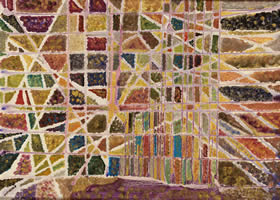critics
RENEE (RENATA SPURIA): BENEATH THE PERCEPTIBLE SURFACE
Renèe, a painter from Rome, has a strong individual personality, and as such cannot be easily classified in one or other of the schools of thought that currently characterise painting.
Her work may be defined as abstract/informal, of an expressionist nature, not only as she the artist sees it, and in terms of her intense feeling, culture and professional development, but also because of the urgent need to consider painting as not only a means of expression and communication, but also as the centre of a universe, a world, an experience that sees the artist as the principal play-maker.
Her paintings seem to constantly take account of the final outcome and effect, which are always convincing in all situations and with any subject she chooses to deal with, measure herself against and counter; her unusual technical awareness and artistic capacity are always accompanied not only by the pleasure she gets from painting, but also by substantial, significant human, cultural, ideological and artistic implications.
Renèe’s paintings may appear a mere skilful exercise to a more superficial observer. This could be no further from the truth, in that this sicilian artist’s work is very much alive and complex, full of stimuli, feelings, values, references, subtle allusions, mysterious, at times worrying, presences/absences, which ought to be looked for, allowed to catch one’s sight, to reflect upon, to feel deep in one’s heart, if they are to fully appreciated and enjoyed.
Painting for Renèe is akin to attempting to follow an ever-changing, veiled, uncertain reality, a reality that is fleetingly glimpsed, guessed at or even perceived in a premonition, but is never actually grasped or capable of being grasped.Such painting has no objective referents, nor any simple, attractive narrative tendencies, but merely dialogues with itself in the constant pursuit of a kind of mysterious alphabet, the completeness of which has been lost, but which we have managed to preserve the elusive, arcane harmony.
All of this is rendered by the artist by means of subtle games she plays with colours, at times compact, at others frayed, sometimes vaporous, sometimes more intense, which give the composition a personal fluidity to the point where this “mass” of colours, let loose upon the canvas, creates an elegant, harmonious overall effect: everything is pervaded by a kind of underlying dreamlike quality, by the painting’s capacity to envelop observers and draw them into the artist’s world, in a relationship between the real world the and the work of art that becomes synonymous with creation. As Paul Klee wrote in his diaries: “The creation exists as a genesis beneath the visible surface of the work”.
From this viewpoint, the painting becomes a filter which separates out all daily anguish and worry, in order to project itself in the realm of creativity, the confines of which are completely free and never definable or traceable.
However, the painting is also the result of Renèe’s interior message. She wishes to investigate reality and our daily existence in order to reach the essence, the spiritual dimension of her experience.
In this sense, Renèe shows that she is not only a good painter, but also an excellent artist due to her capacity to silently, humbly scrutinise the infinite opportunities that her creativity, her considerable humanity and her profound sensitivity, give her to present herself, and to suggest images capable of unthinkable, unimaginable, out of the ordinary developments.
LUCIANO LEPRI

